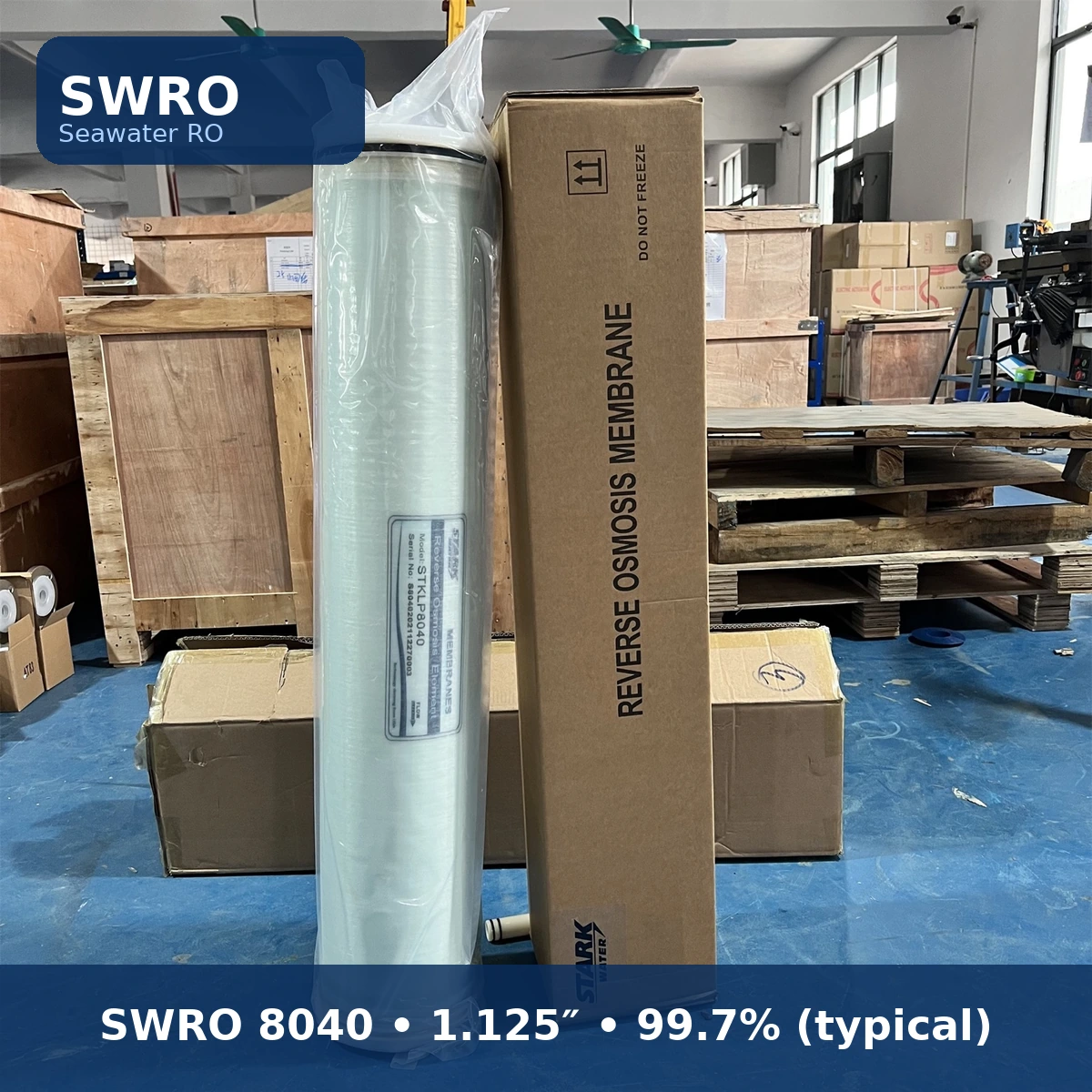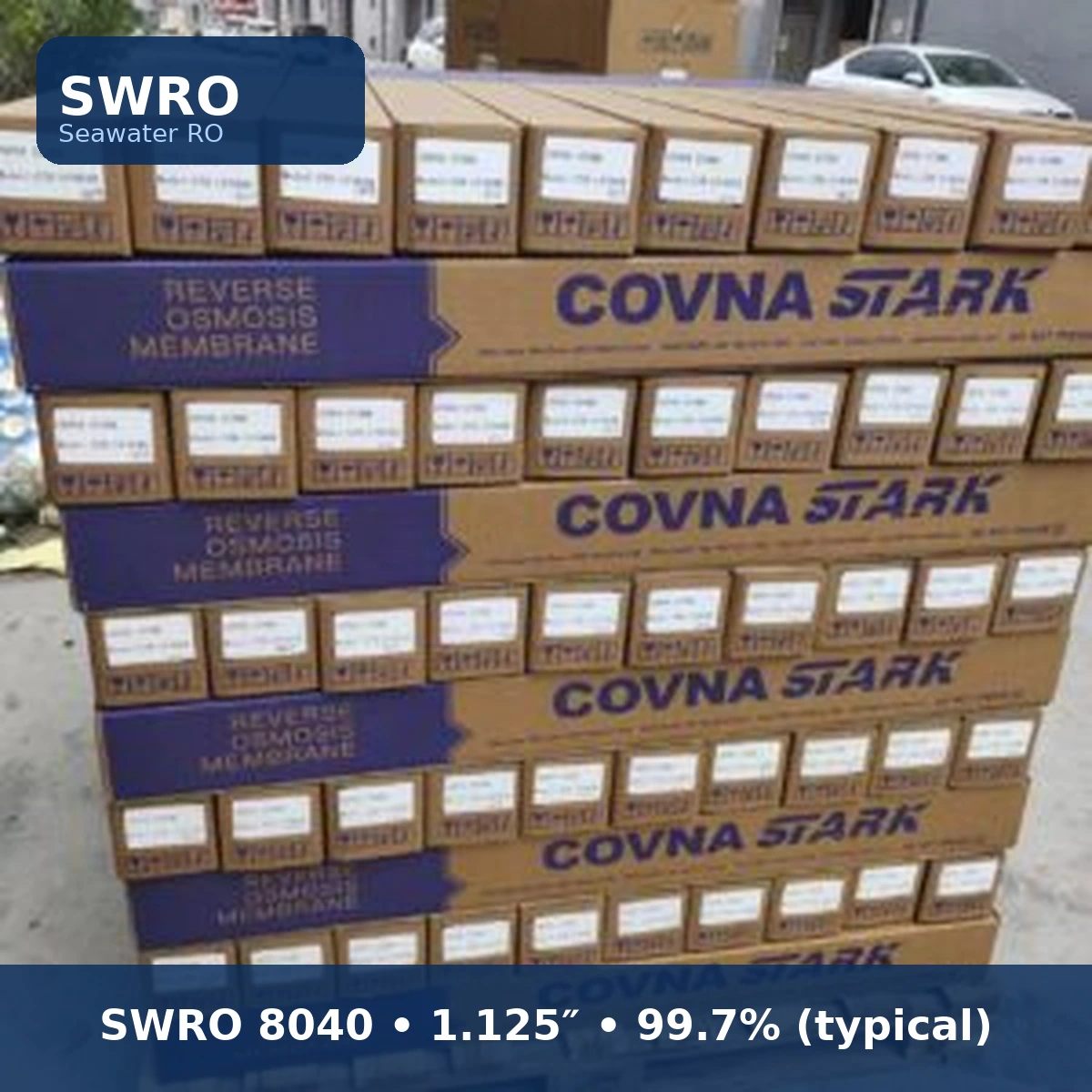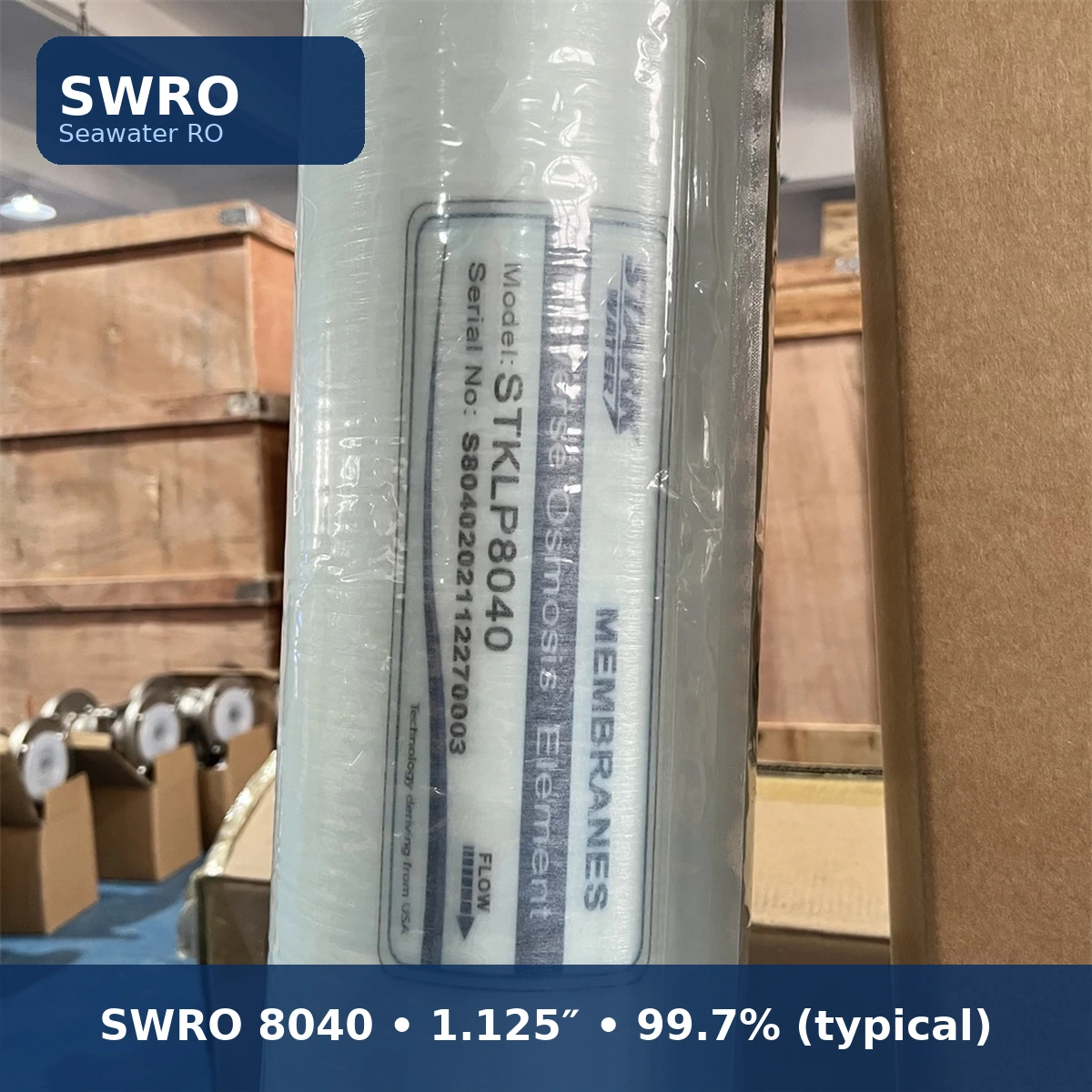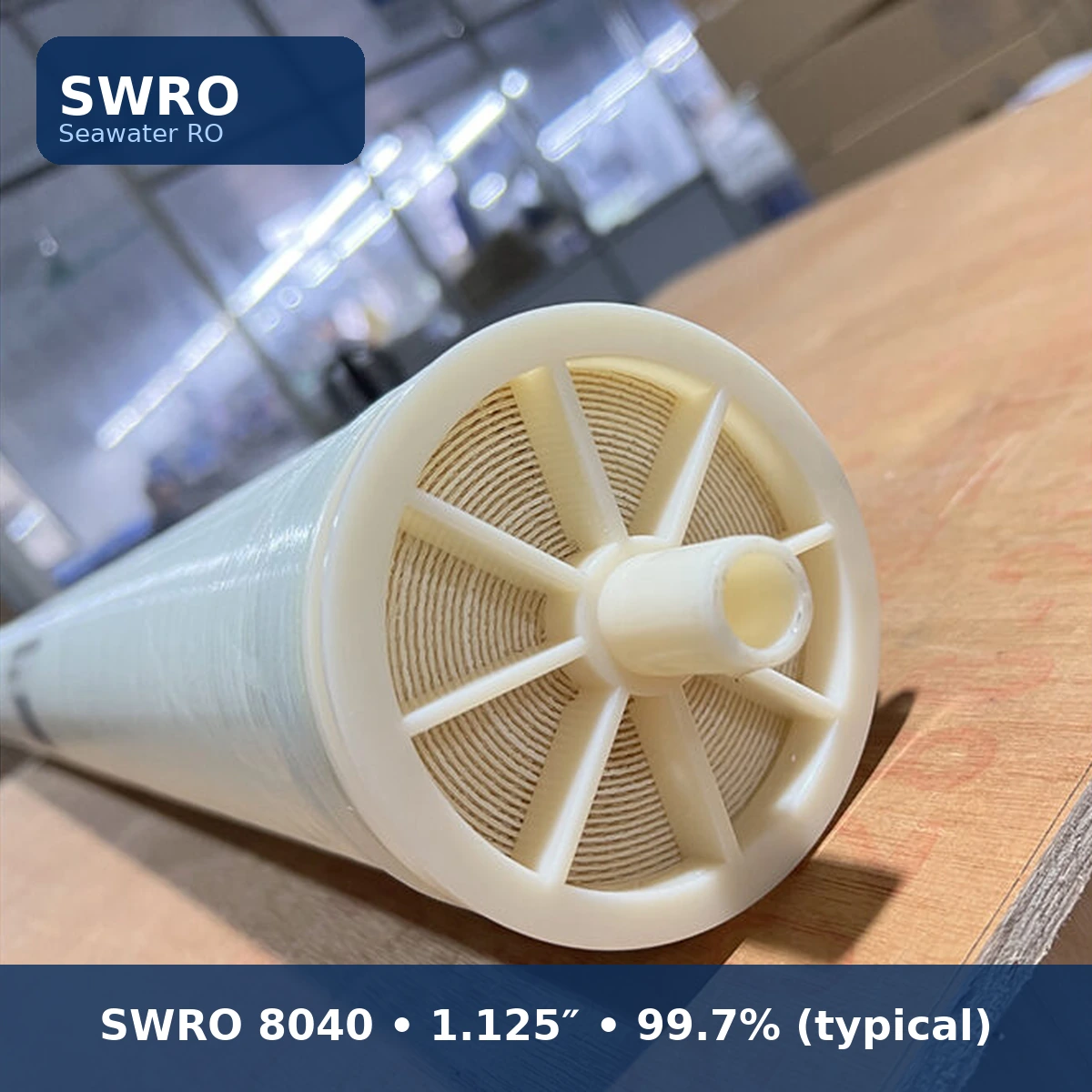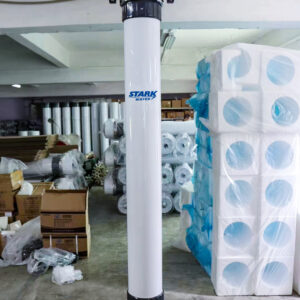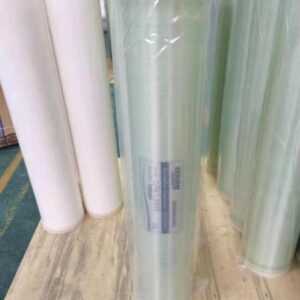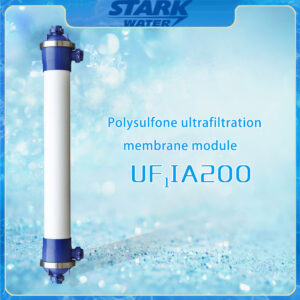 SWRO 8040 Membrana de ósmosis inversa de alto rechazo
SWRO 8040 Membrana de ósmosis inversa de alto rechazoSWRO 8040 Membrana de ósmosis inversa de alto rechazo
SWRO 8040 high-rejection seawater reverse osmosis membrane for first-pass desalination. Rated around 32,000 mg/L NaCl en 25 °C with typical operating pressure near 800 psi. Typical salt rejection up to 99.7% when pretreatment, recovery, and temperature follow supplier limits.
Descripción del producto
This SWRO 8040 RO membrane is engineered for first-pass seawater desalination, combining high salt rejection with stable flux under standard SWRO test conditions.
This 8.0″ × 40″ thin-film composite (TFC) Membrana de ósmosis inversa is built for industrial and municipal seawater lines that need high rejection, predictable flux, and compatibility with standard 8040 pressure vessels and interconnectors. It integrates cleanability and preservation guidance so operators can maintain stable product water over the service life.
Key features
- High salt rejection (typical up to 99.7%) for low product conductivity.
- Optimized feed spacer for stable differential pressure and cleaning recovery.
- 1.125″ permeate tube ID; drop-in fit for standard 8040 vessels and couplers.
- Works with staged arrays and energy recovery devices in SWRO trains.
- Supported by approved CIP chemistry y preservation procedures.
Interfaces & compatibility
- Format: 8040 TFC polyamide element
- Permeate tube: 1.125″ (28.6 mm)
- Vessels/couplers: standard 8″ multi-element pressure vessels with interconnectors
- Change-out: replace like-for-like in most 8040 housings
Operating & cleaning limits*
- Max temperature: 45 °C (113 °F)
- pH range (operation): 2-11; (cleaning): 1–12
- Max pressure: 1,200 psi (8.3 MPa)
- Free chlorine: not recommended on TFC unless the datasheet explicitly allows; dechlorinate upstream
*Always verify the exact limits on the current model datasheet.
Typical test conditions
32,000 mg/L NaCl, 25 °C, ~800 psi, ~8% recovery. In service, performance varies with temperature, salinity, recovery, and pretreatment (SDI/MFI, antiscalant window).
What’s included and Why choose this SWRO 8040 RO membrane
- Factory-preserved element in sealed bag
- Installation & torque notes; cleaning/preservation guidance (download)
Need field criteria? See Sustitución de la membrana de ósmosis inversa, cleaning & CIPy troubleshooting matrix.
Parámetros del producto
| Tamaño del elemento | 8.0″ × 40″ (8040) |
|---|---|
| Active area | ~37 m² (400 ft²), model dependent |
| Typical salt rejection | up to 99.7% (datasheet dependent) |
| Rated permeate flow (window) | ~28–34 m³/d (7,500–9,000 gpd) @ 32,000 mg/L, 25 °C |
| Permeate tube ID | 1.125″ (28.6 mm) |
| Max operating pressure | 1,200 psi (8.3 MPa) |
| Max temperature | 45 °C (113 °F) |
| pH range | 2-11 operation; 1–12 cleaning |
| Test conditions | 32,000 mg/L NaCl; 25 °C; ~800 psi; ~8% recovery |
Values shown are typical for listing purposes; final selection should follow the current model datasheet.For most retrofits, this swro 8040 ro membrane drops into standard 8″ vessels with 1.125″ permeate tubes.
Industria aplicable
- Seawater desalination (first-pass SWRO) for municipalities
- Coastal hotels, island resorts, marine/offshore watermakers
- Industrial process water where seawater feed requires high rejection
Ventaja Uno
Advantage 1 — High rejection for stable product water
Deliver consistently low product conductivity with robust polyamide selectivity and flow-balanced feed spacers that help control differential pressure across stages.Ventaja DOS
Advantage 2 — Drop-in 8040 compatibility and serviceability
Standard 1.125″ permeate tube and multi-element vessel coupling enable fast change-outs in existing housings. Supported by clear acceptance criteria after start-up: normalized permeate flow ≥ 90-100% of the clean baseline, rejection at spec, and stage ΔP within limits.Productos relacionados
Productos relacionados
PREGUNTAS FRECUENTES
P1: ¿Cuánto dura el sistema de ósmosis inversa?
La vida útil de un sistema de ósmosis inversa depende de la calidad del agua y del mantenimiento. Normalmente, la membrana dura entre 2 y 3 años, mientras que el sistema en sí puede durar más de 10 años con los cuidados adecuados.
P2: ¿Se puede personalizar el sistema en función de las diferentes condiciones del agua?
Sí, todos nuestros sistemas son totalmente personalizables. Analizamos su informe de aguas y sus necesidades de aplicación antes de ofrecerle soluciones a medida.
P3: ¿Qué normas cumplen los equipos STARK?
Nuestros productos cumplen las normas CE e ISO 9001, y pueden diseñarse para cumplir normativas regionales o estándares industriales específicos si así se solicita.
P4: ¿Cuál es el plazo de entrega de los sistemas de ósmosis inversa STARK?
Los sistemas estándar se envían en un plazo de 7-15 días. Para los pedidos personalizados, el plazo de entrega puede prolongarse hasta 20-25 días en función de la complejidad.
P5: ¿Ofrecen asistencia técnica u orientación para la instalación?
Sí. Proporcionamos documentación técnica completa, asistencia remota por vídeo y podemos enviar ingenieros al extranjero si así se solicita.
P6: ¿Qué incluye su presupuesto?
Nuestro presupuesto incluye el sistema de ósmosis inversa completo, el panel de control, las bombas, las unidades de pretratamiento y todos los accesorios necesarios. Si lo desea, podemos incluir herramientas de instalación y piezas de repuesto.

